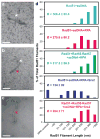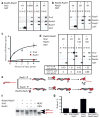Rad51 paralogues Rad55-Rad57 balance the antirecombinase Srs2 in Rad51 filament formation
- PMID: 22020281
- PMCID: PMC3213327
- DOI: 10.1038/nature10522
Rad51 paralogues Rad55-Rad57 balance the antirecombinase Srs2 in Rad51 filament formation
Abstract
Homologous recombination is a high-fidelity DNA repair pathway. Besides a critical role in accurate chromosome segregation during meiosis, recombination functions in DNA repair and in the recovery of stalled or broken replication forks to ensure genomic stability. In contrast, inappropriate recombination contributes to genomic instability, leading to loss of heterozygosity, chromosome rearrangements and cell death. The RecA/UvsX/RadA/Rad51 family of proteins catalyses the signature reactions of recombination, homology search and DNA strand invasion. Eukaryotes also possess Rad51 paralogues, whose exact role in recombination remains to be defined. Here we show that the Saccharomyces cerevisiae Rad51 paralogues, the Rad55-Rad57 heterodimer, counteract the antirecombination activity of the Srs2 helicase. The Rad55-Rad57 heterodimer associates with the Rad51-single-stranded DNA filament, rendering it more stable than a nucleoprotein filament containing Rad51 alone. The Rad51-Rad55-Rad57 co-filament resists disruption by the Srs2 antirecombinase by blocking Srs2 translocation, involving a direct protein interaction between Rad55-Rad57 and Srs2. Our results demonstrate an unexpected role of the Rad51 paralogues in stabilizing the Rad51 filament against a biologically important antagonist, the Srs2 antirecombination helicase. The biological significance of this mechanism is indicated by a complete suppression of the ionizing radiation sensitivity of rad55 or rad57 mutants by concomitant deletion of SRS2, as expected for biological antagonists. We propose that the Rad51 presynaptic filament is a meta-stable reversible intermediate, whose assembly and disassembly is governed by the balance between Rad55-Rad57 and Srs2, providing a key regulatory mechanism controlling the initiation of homologous recombination. These data provide a paradigm for the potential function of the human RAD51 paralogues, which are known to be involved in cancer predisposition and human disease.
Figures




Similar articles
-
The Rad51 paralog complex Rad55-Rad57 acts as a molecular chaperone during homologous recombination.Mol Cell. 2021 Mar 4;81(5):1043-1057.e8. doi: 10.1016/j.molcel.2020.12.019. Epub 2021 Jan 8. Mol Cell. 2021. PMID: 33421364 Free PMC article.
-
Rad51 filaments assembled in the absence of the complex formed by the Rad51 paralogs Rad55 and Rad57 are outcompeted by translesion DNA polymerases on UV-induced ssDNA gaps.PLoS Genet. 2023 Feb 7;19(2):e1010639. doi: 10.1371/journal.pgen.1010639. eCollection 2023 Feb. PLoS Genet. 2023. PMID: 36749784 Free PMC article.
-
Promotion of presynaptic filament assembly by the ensemble of S. cerevisiae Rad51 paralogues with Rad52.Nat Commun. 2015 Jul 28;6:7834. doi: 10.1038/ncomms8834. Nat Commun. 2015. PMID: 26215801 Free PMC article.
-
The Role of the Rad55-Rad57 Complex in DNA Repair.Genes (Basel). 2021 Sep 8;12(9):1390. doi: 10.3390/genes12091390. Genes (Basel). 2021. PMID: 34573372 Free PMC article. Review.
-
Functions of the Snf2/Swi2 family Rad54 motor protein in homologous recombination.Biochim Biophys Acta. 2011 Sep;1809(9):509-23. doi: 10.1016/j.bbagrm.2011.06.006. Epub 2011 Jun 16. Biochim Biophys Acta. 2011. PMID: 21704205 Free PMC article. Review.
Cited by
-
RecA: Regulation and Mechanism of a Molecular Search Engine.Trends Biochem Sci. 2016 Jun;41(6):491-507. doi: 10.1016/j.tibs.2016.04.002. Epub 2016 May 4. Trends Biochem Sci. 2016. PMID: 27156117 Free PMC article. Review.
-
The Shu complex interacts with Rad51 through the Rad51 paralogues Rad55-Rad57 to mediate error-free recombination.Nucleic Acids Res. 2013 Apr;41(8):4525-34. doi: 10.1093/nar/gkt138. Epub 2013 Mar 4. Nucleic Acids Res. 2013. PMID: 23460207 Free PMC article.
-
Synthetic lethality between gene defects affecting a single non-essential molecular pathway with reversible steps.PLoS Comput Biol. 2013 Apr;9(4):e1003016. doi: 10.1371/journal.pcbi.1003016. Epub 2013 Apr 4. PLoS Comput Biol. 2013. PMID: 23592964 Free PMC article.
-
Biochemical attributes of mitotic and meiotic presynaptic complexes.DNA Repair (Amst). 2018 Nov;71:148-157. doi: 10.1016/j.dnarep.2018.08.018. Epub 2018 Aug 23. DNA Repair (Amst). 2018. PMID: 30195641 Free PMC article. Review.
-
Swi5-Sfr1 stimulates Rad51 recombinase filament assembly by modulating Rad51 dissociation.Proc Natl Acad Sci U S A. 2018 Oct 23;115(43):E10059-E10068. doi: 10.1073/pnas.1812753115. Epub 2018 Oct 8. Proc Natl Acad Sci U S A. 2018. PMID: 30297419 Free PMC article.
References
Publication types
MeSH terms
Substances
Grants and funding
LinkOut - more resources
Full Text Sources
Other Literature Sources
Molecular Biology Databases
Research Materials

